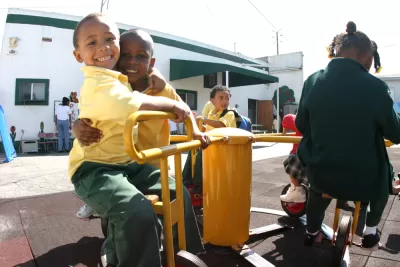With asphalt temperatures reaching as much as 150 degrees, parents and advocates are asking the city’s school district to provide more shade, trees, and other heat mitigation features on its schoolyards and playgrounds.

Parents and advocates are calling on the Los Angeles Unified School District to implement more heat mitigation measures on its school playgrounds, where asphalt can reach temperatures of 150 degrees Fahrenheit, reports Jasmine Viel for CBS Los Angeles.
“LAUSD is one of the largest landowners in the city, owning 6,400 acres of schoolyards. These schoolyards that are covered in asphalt are some of the hottest places in every single neighborhood,” says Aleigh Lewis of Angelenos for Green Schools. While the district has announced plans to add more trees and greenery to its schoolyards, some parents are calling for more immediate action. “The quickest option, if you can't wait for trees to grow, is to just put shade structures,” said LAUSD parent Connor Clayton.
The Los Angeles Times brought attention to the issue in March, when Tony Barboza detailed the negative impacts of overheated asphalt schoolyards. Barboza noted that LAUSD’s superintendent, Alberto Carvalho, “promised to release a plan within his first 100 days to green schoolyards, starting with asphalt-dominated campuses in neighborhoods with the greatest need for open space.”
In June, the district announced a new budget that includes funding for ‘greening schoolyards’ as well as a pilot program at Castellanos Elementary, reported Erin Stone in LAist. According to Stone’s article, “A recent study by the Trust for Public Land found that when factoring in benefits gained by greening schools, such as increased student attendance, better test scores, higher teacher retention and lower utility costs as a result of a cooler campus, California schools could save $600,000 over 20 years per campus.”
FULL STORY: LAUSD parents call for changes to school playgrounds amid scorching temperatures

Alabama: Trump Terminates Settlements for Black Communities Harmed By Raw Sewage
Trump deemed the landmark civil rights agreement “illegal DEI and environmental justice policy.”

Planetizen Federal Action Tracker
A weekly monitor of how Trump’s orders and actions are impacting planners and planning in America.

The 120 Year Old Tiny Home Villages That Sheltered San Francisco’s Earthquake Refugees
More than a century ago, San Francisco mobilized to house thousands of residents displaced by the 1906 earthquake. Could their strategy offer a model for the present?

In Both Crashes and Crime, Public Transportation is Far Safer than Driving
Contrary to popular assumptions, public transportation has far lower crash and crime rates than automobile travel. For safer communities, improve and encourage transit travel.

Report: Zoning Reforms Should Complement Nashville’s Ambitious Transit Plan
Without reform, restrictive zoning codes will limit the impact of the city’s planned transit expansion and could exclude some of the residents who depend on transit the most.

Judge Orders Release of Frozen IRA, IIJA Funding
The decision is a victory for environmental groups who charged that freezing funds for critical infrastructure and disaster response programs caused “real and irreparable harm” to communities.
Urban Design for Planners 1: Software Tools
This six-course series explores essential urban design concepts using open source software and equips planners with the tools they need to participate fully in the urban design process.
Planning for Universal Design
Learn the tools for implementing Universal Design in planning regulations.
Clanton & Associates, Inc.
Jessamine County Fiscal Court
Institute for Housing and Urban Development Studies (IHS)
City of Grandview
Harvard GSD Executive Education
Toledo-Lucas County Plan Commissions
Salt Lake City
NYU Wagner Graduate School of Public Service





























